#amazonomachy
Text





AMAZONOMACHY:
Attic Red-figured Column Krater
Attributed to the Polignotos Painter
https://en.wikipedia.org/wiki/Polygnotos_(vase_painter)
450-440 BC
Side A:
Two Amazons [depicted in Hellenic clothing, one with a sagaris] confront two Greek warriors.
From Tomb 724B, the Valle Pega, Chiusi area [near Ferrara], Spina.
Museo Archeologico Nazionale di Ferrara | MANF
[1st Fl. Sala XV]
• Web : http://www.archeoferrara.beniculturali.it/index.aspx?lng=ENG
• FB : https://www.facebook.com/museo.archeologico.ferrara
• IG : @museo_archeologico_ferrara
• X : @ArcheoFerrara
MANF | Michael Svetbird phs©msp | 21|02|24 5500X4200 600 [I.-V.]
The photographed object is collection item of MANF, photos are copyrighted
[non commercial use | sorry for the watermarks]
.
#ferrara#archaeological museum#attica#krater#red figure pottery#vase painting#ancient pottery#pottery#ancient art#antiquity#ancient#archaeology#museology#museum#mythology#greek mythology#art history#antiquities#heritage#culture#amazonomachy#amazons#αμαζόνες#amazzoni#oiorpata#warriors#art photography#archaeology photography#museum photography#michaelsvetbird
20 notes
·
View notes
Text
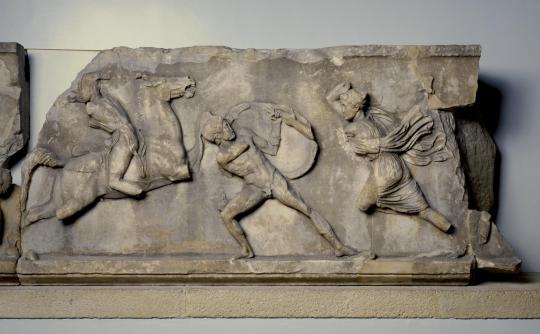

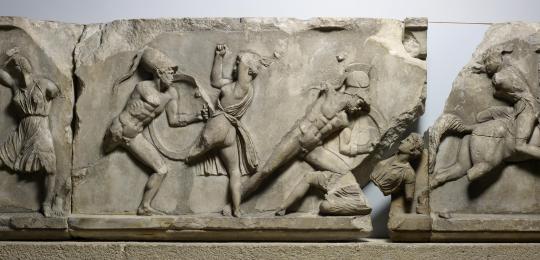



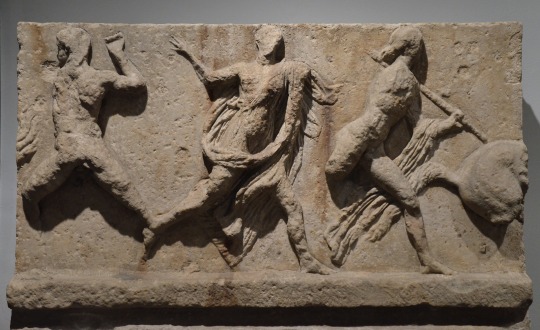
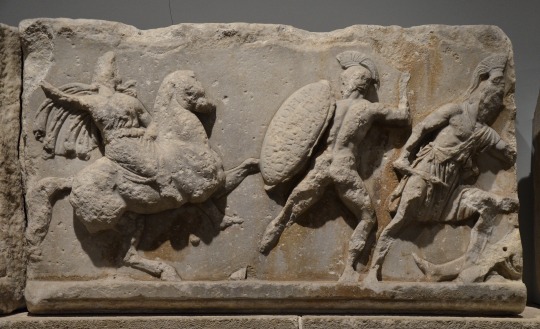







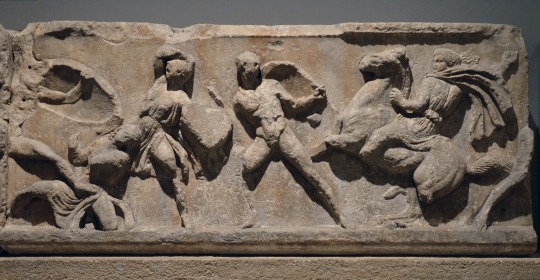
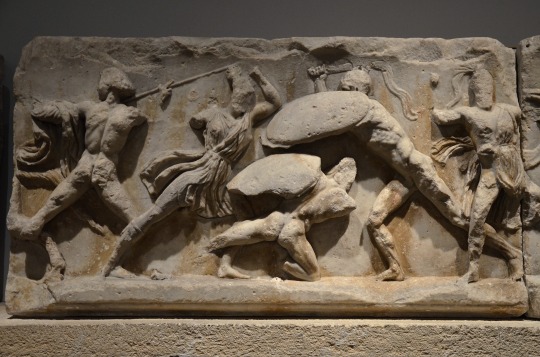


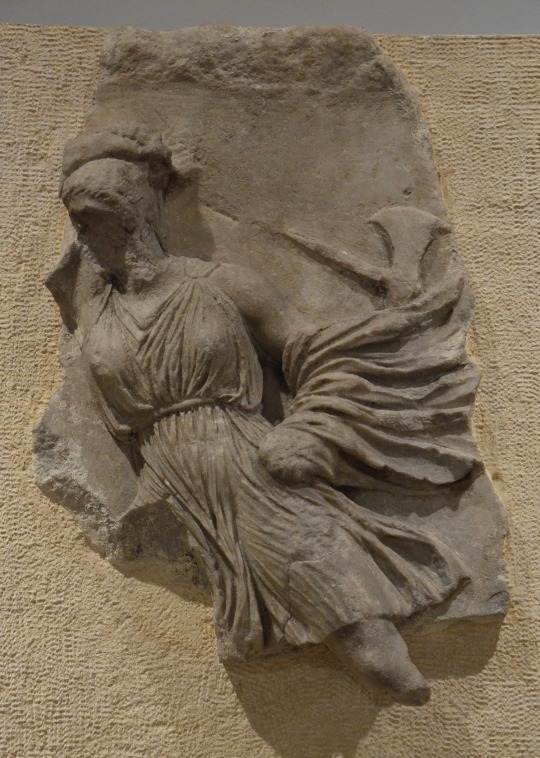


Amazonomachy frieze at the Mausoleum of Halikarnassos 350 BCE. Images from British Museum, Carole Raddato's flickr, & Mary Harrsch's flickr.
"About the Sauromatae, the story is as follows. When the Greeks were at war with the Amazons (whom the Scythians call Oiorpata, a name signifying in our tongue killers of men, for in Scythian a man is “oior” and to kill is “pata”), the story runs that after their victory on the Thermodon they sailed away carrying in three ships as many Amazons as they had been able to take alive; and out at sea the Amazons attacked the crews and killed them. But they knew nothing about ships, or how to use rudder or sail or oar; and with the men dead, they were at the mercy of waves and winds, until they came to the Cliffs by the Maeetian lake; this place is in the country of the free Scythians. The Amazons landed there, and set out on their journey to the inhabited country, and seizing the first troop of horses they met, they mounted them and raided the Scythian lands.
The Scythians could not understand the business; for they did not recognize the women's speech or their dress or their nation, but wondered where they had come from, and imagined them to be men all of the same age; and they met the Amazons in battle. The result of the fight was that the Scythians got possession of the dead, and so came to learn that their foes were women.
Therefore, after deliberation they resolved by no means to slay them as before, but to send their youngest men to them, of a number corresponding (as they guessed) to the number of the women. They directed these youths to camp near the Amazons and to imitate all that they did; if the women pursued them, not to fight, but to flee; and when the pursuit stopped, to return and camp near them. This was the plan of the Scythians, for they desired that children be born of the women. The young men who were sent did as they were directed. When the Amazons perceived that the youths meant them no harm, they let them be; but every day the two camps drew nearer to each other.
Now the young men, like the Amazons, had nothing but their arms and their horses, and lived as did the women, by hunting and plunder. At midday the Amazons would scatter and go apart from each other singly or in pairs, roaming apart for greater comfort. The Scythians noticed this and did likewise; and as the women wandered alone, a young man laid hold of one of them, and the woman did not resist but let him do his will; and since they did not understand each other's speech and she could not speak to him, she signed with her hand that he should come the next day to the same place and bring another youth with him (showing by signs that there should be two), and she would bring another woman with her.
The youth went away and told his comrades; and the next day he came himself with another to the place, where he found the Amazon and another with her awaiting them. When the rest of the young men learned of this, they had intercourse with the rest of the Amazons. Presently they joined their camps and lived together, each man having for his wife the woman with whom he had had intercourse at first.
Now the men could not learn the women's language, but the women mastered the speech of the men; and when they understood each other, the men said to the Amazons, “We have parents and possessions; therefore, let us no longer live as we do, but return to our people and be with them; and we will still have you, and no others, for our wives.” To this the women replied: “We could not live with your women; for we and they do not have the same customs. We shoot the bow and throw the javelin and ride, but have never learned women's work; and your women do none of the things of which we speak, but stay in their wagons and do women's work, and do not go out hunting or anywhere else. So we could never agree with them. If you want to keep us for wives and to have the name of fair men, go to your parents and let them give you the allotted share of their possessions, and after that let us go and live by ourselves.” The young men agreed and did this.
So when they had been given the allotted share of possessions that fell to them, and returned to the Amazons, the women said to them: “We are worried and frightened how we are to live in this country after depriving you of your fathers and doing a lot of harm to your land. Since you propose to have us for wives, do this with us: come, let us leave this country and live across the Tanaïs river.” To this too the youths agreed; and crossing the Tanaïs, they went a three days' journey east from the river, and a three days' journey north from lake Maeetis; and when they came to the region in which they now live, they settled there. Ever since then the women of the Sauromatae have followed their ancient ways; they ride out hunting, with their men or without them; they go to war, and dress the same as the men. The language of the Sauromatae is Scythian, but not spoken in its ancient purity, since the Amazons never learned it correctly. In regard to marriage, it is the custom that no maiden weds until she has killed a man of the enemy; and some of them grow old and die unmarried, because they cannot fulfill the law."
-Herodotus, The Histories 4.110.1
I collected more images on my blog page than I can post here: https://paganimagevault.blogspot.com/2022/10/amazonomachy-frieze-at-mausoleum-of.html
#amazonomachy#amazons#ancient greece#scythian#antiquities#sculpture#art#greek#history#museums#the british museum#statue#literature#ancient history#4th century bce
112 notes
·
View notes
Text

Bassae frieze (6)
* Temple of Apollo at Bassae
* 420-400 BCE
* British Museum
London, July 2022
#Bassae Frieze#5th century BCE#Temple of Apollo#amazonomachy#ancient#Greek#art#mythology#frieze#amazon#clothing#Bassae#my photo#British Museum
42 notes
·
View notes
Text
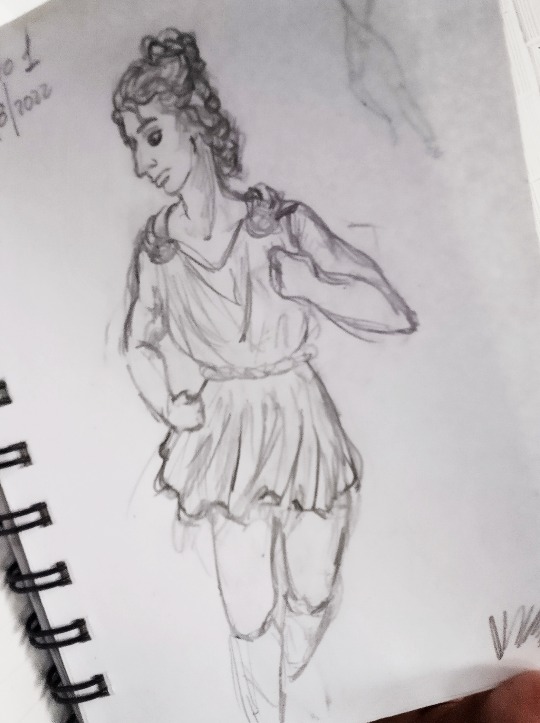
Concept sketch of an Amazon running
4 notes
·
View notes
Photo



Katee Sackhoff as Bo-Katan Kryze in The Mandalorian
#rip to koska and axe but im different#the mandalorian#themandalorianedit#swedit#bo katan kryze#katee sackhoff#star wars#the mandalorian spoilers#the apostate#also I love the frieze it's giving parthenon amazonomachy <3
244 notes
·
View notes
Photo
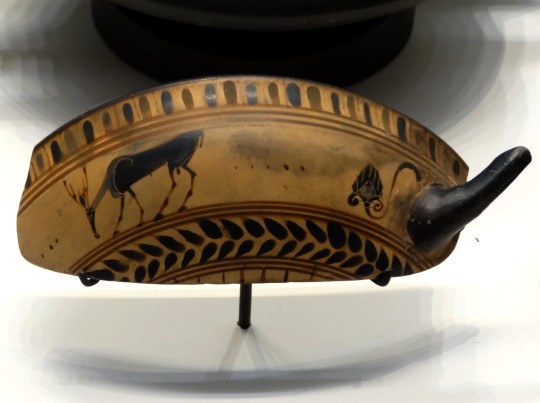

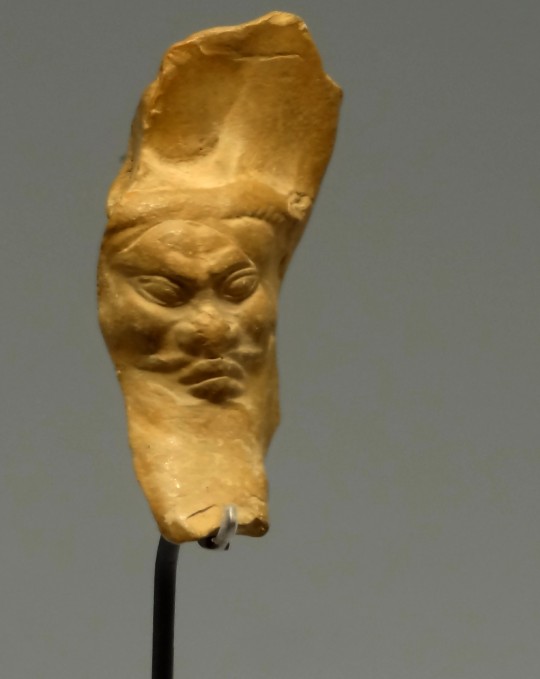


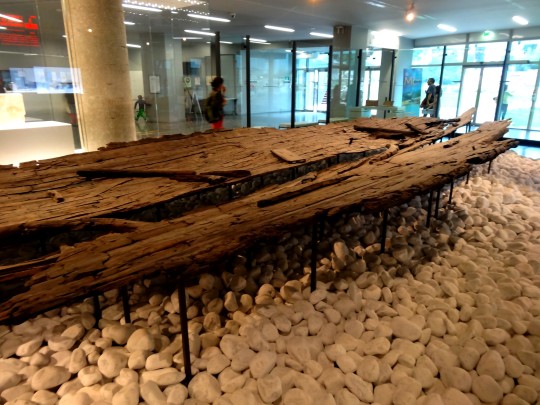
Nouveau retour à mon projet de présenter la plupart de mes 55500 photos (et des brouettes). Plus trop loin du présent….
2016. Marseille en octobre, Le Musée d’Histoire de Marseille.
- coupe attique, Massalia, 540 av. J-C.
- amazonomachie sur coupe massaliète - 450 av. J-C.
- fragment d’askos : dieu-fleuve - baou de St-Marcel, 500 av.J-C.
- l'”Hermès Bicéphale"- oppidum celto-ligure de Roquepertuse, IIIe. s. av.JC.
- 4 têtes de chevaux sur linteau - oppidum celto-ligure de Roquepertuse, IIIe. s. av.J-C.
- épave grecque massaliote de la Place Jules Verne, 550 avJ-C.
#souvenirs#marseille#musée d'histoire#archéologie#grèce antique#massalia#attique#coupe#askos#amazone#amazonomachie#massaliote#massaliète#baou#baou de saint-marcel#dieu-fleuve#ligure#celto-ligure#hermès#hermès bicéphale#roquepertuse#oppidum#cheval#chevaux#épave#épave antique
2 notes
·
View notes
Text
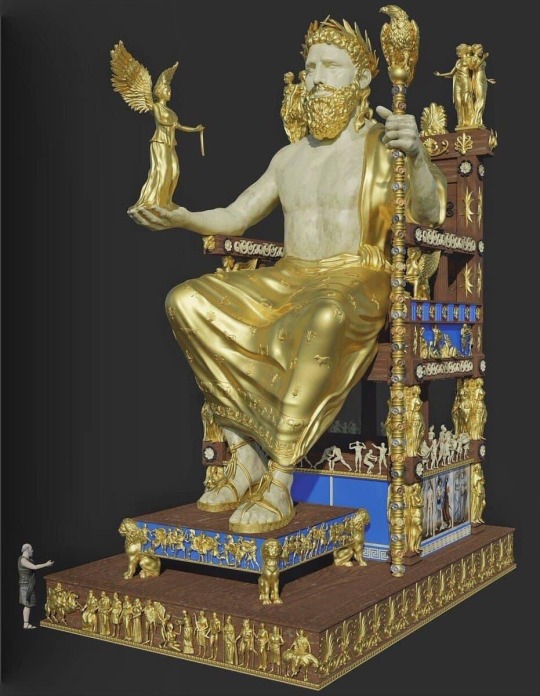
The monumental Statue of Zeus at Olympia in Greece was one of the Seven Wonders of the Ancient World. Created in the 430s BCE under the supervision of the master Greek sculptor Phidias, the huge ivory and gold statue was bigger even than that of Athena in the Parthenon. Worshipped by pilgrims from across the Mediterranean, the statue inspired countless imitations and defined the standard representation of Zeus in Greek and Roman art in sculpture, on coins, pottery, and gemstones. Lost in later Roman times following its removal to Constantinople, Phidias' masterpiece captivated the ancient world for 1,000 years and was the must-see sight for anyone who attended the ancient Olympic Games.
The statue of mighty Zeus was over 12.4 m (41 ft) high and represented the god seated on a throne. It was bigger even than Phidias' Athena Parthenos in Athens. The Zeus statue, like Athena, was chryselephantine, that is a combination of gold and ivory over a wooden core, with the god's skin (face, torso, arms and legs) being in ivory and his beard, robes, and staff rendered in brilliant gold, applied in hammered sheets. Fine details were picked out using a wide variety of materials: silver, copper, glass (for the decorative lilies of the god's robes), ebony, enamel, paint, and jewels. The clay moulds discovered in Phidias' workshop for a similar statue suggest that it was first erected there in pieces - the size of the workshop is exactly the same dimensions as the inner cella of the temple - and then reassembled at its final destination. The wooden core could not have been fully sculpted or the moulds would have been unnecessary to shape the outer gold pieces.
Zeus' throne - made using ivory, ebony, and gold, and encrusted with glass and gems - was embellished with relief sculpture depicting a wide range of figures from Greek mythology, many of which were considered the offspring of Zeus. There are the Graces (Charites), the Seasons (Horae), various Nikes, sphinxes, Amazons, and the children of Niobe. The screens between the legs of the throne were painted by Phidias' brother Panaenus (Panainos) and depicted the Labours of Hercules, Achilles with Penthesilea, Hippodamia with Sterope, Salamis, and scenes of Greece. The god rested his feet upon a footstool which was decorated with a battle scene involving Theseus fighting Amazons (Amazonomachy).
209 notes
·
View notes
Photo

Oval cista with Amazonomachy. Vulci, 340 - 300 B.C., bronze. Gregorian Etruscan Museum. (x)
[image description: small bronze container with feet described above. the sculpted handle on the lid depicts a man and a woman on the backs of two geese. the sides of the container are elaborately embossed. the side visible in the image is decorated with a frieze of armed Amazons and delicate floral patterns. end id.]
334 notes
·
View notes
Text
Early modern depictions of the Amazons tended to focus both on a fascination with the ancient world and with the idea of a woman-led society, but also with the civilizations that Europeans were discovering — and often subjugating.
Peter Paul Rubens, the baroque master, took a couple of stabs at an Amazonomachy. Here’s his first, painted with help from Jan Brueghel the Elder, from around 1600:
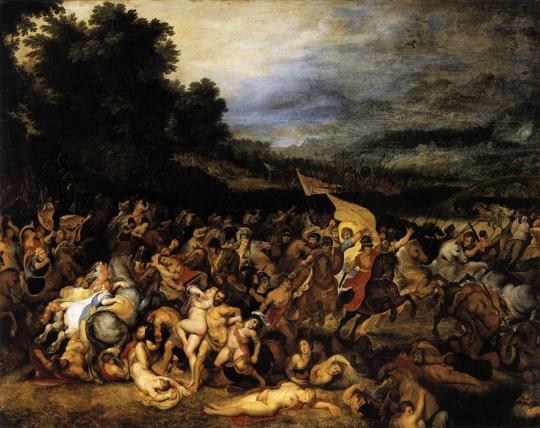
{WHF} {Ko-Fi} {Medium}
54 notes
·
View notes
Text

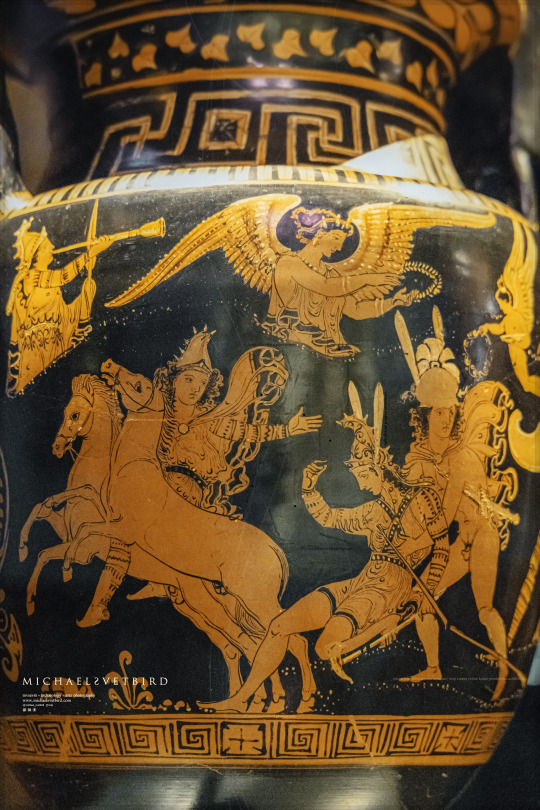


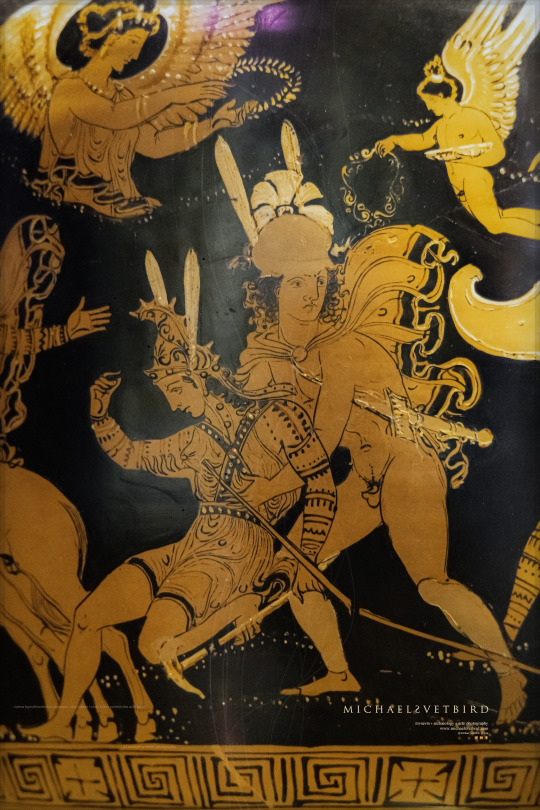
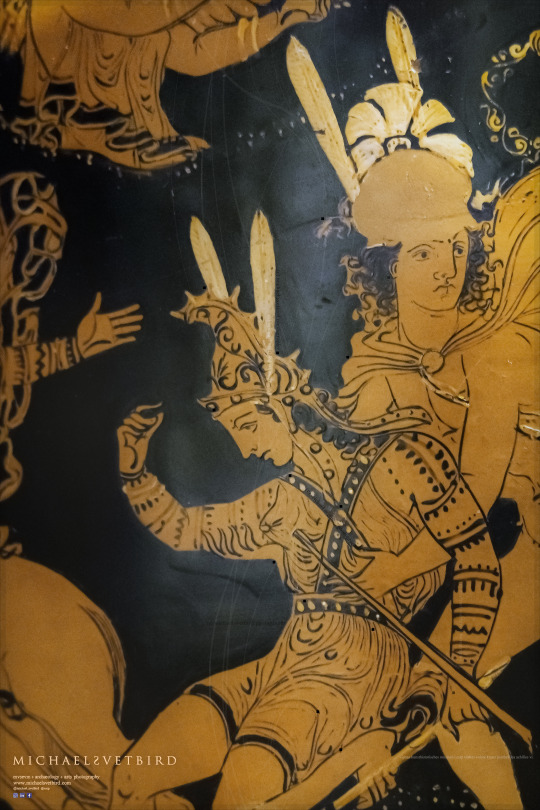
VOLUTE KRATER Depicting Penthesilea and Achilles, Amazonomachy
Attributed to the Ilioupersis [Iliupersis] Painter
https://en.wikipedia.org/wiki/Ilioupersis_Painter
Side A: Penthesilea, Achilles, Left - "Amazon with the Queen's horse rearing up. Above - the Goddess of victory Nike and the God of love Eros with wreaths in their hands."
[Side B : Dionysus sitting surrounded by 2 maenads and a satyr].
Apulian Red-figured Volute Krater
2nd quarter of the 4th c. BC
From Taranto | Magna Grecia
KunstHistorisches Museum, Vienna | KHMV
["Ancient Greece and Rome", Kabinett IV]
• Web : https://www.khm.at/en
• FB : https://www.facebook.com/KHMWien
• IG : https://www.instagram.com/kunsthistorischesmuseumvienna
Am sorry about very poor lighting in this Kabinett impacting the pics' quality..
KHMV | Michael Svetbird phs©msp | 13|08|23 6300X4200 600 [I.-III. & V.]
The photographed object is collection item of KHMV, photos are subject to copyrights.
[non commercial use | sorry for the watermarks]
.
#vienna#kunsthistorisches museum#kunsthistorischesmuseum wien#history museum#archaeological museum#vasepainting#ancient pottery#krater#crater#red figure pottery#magna grecia#ancient art#trojan war#achilles#penthesilea#amazonomachy#amazons#αμαζόνες#amazonen#warrioress#oiorpata#amazon queen#antiquity#ancient#archaeology#museology#greek mythology#archaeology photography#museum photography#michaelsvetbird
7 notes
·
View notes
Text

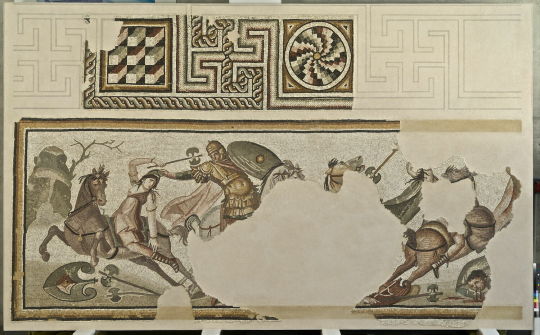

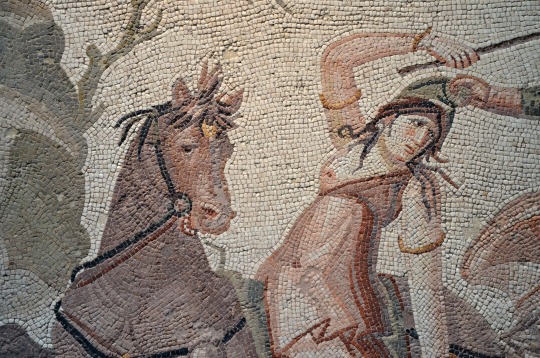

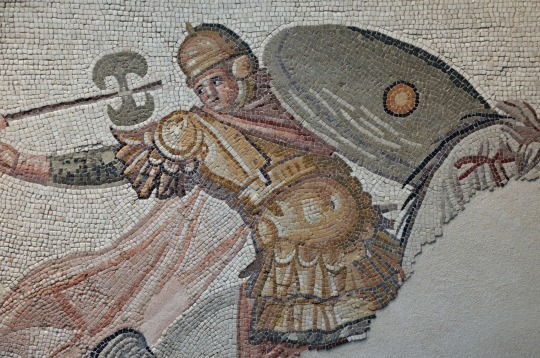
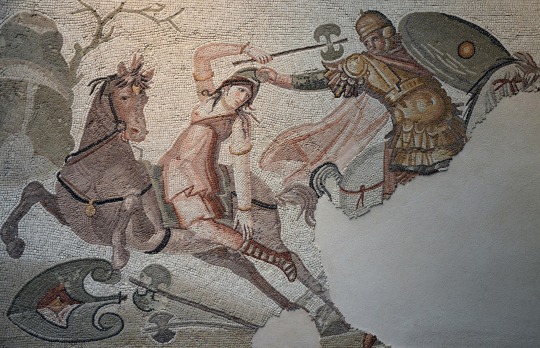
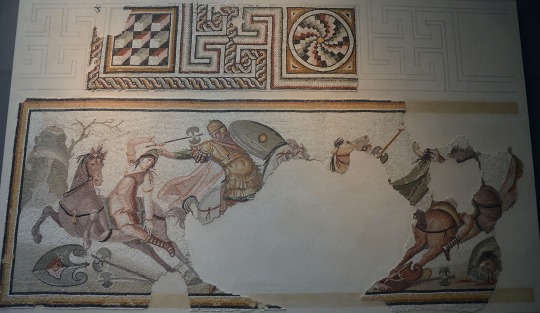
Amazonomachy scene, from Daphne, a suburb of Antioch-on-the-Orontes, second half of the 4th century CE, Louvre Museum. Image from Carole Raddato's flickr.
"The Amazones of the Doiantian plain [by the river Thermodon on the Black Sea] were by no means gently, well-conducted folk; they were brutal and aggressive, and their main concern in life was war. War, indeed, was in their blood, daughters of Ares as they were and of the Nymphe Harmonia, who lay with the God in the depths of the Akmonian (Acmonian) Wood and bore him girls who fell in love with fighting."
-Apollonius Rhodius, Argonautica 2. 986 ff (trans. Rieu) (Greek epic c. 3rd BCE)
#ancient greek#ancient rome#syria#swastika#antiquities#history#literature#pagan#antioch#amazonomachy#amazons#ancient history#art#museums#louvre#4th century#paganism
68 notes
·
View notes
Text
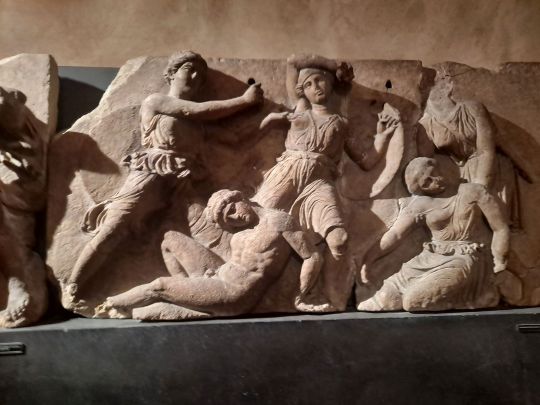
Bassae Frieze - Greeks fight amazons (3)
* Temple of Apollo at Bassae
* 420-400 BCE
* British Museum
London, July 2022
#Bassae frieze#5th century BCE#amazonomachy#Herakles#Hippolyte#labours of Hercules#Greek#ancient#art#frieze#mythology#temple#Apollo#battle#amazon#clothing#Bassae#British Museum#my photo
67 notes
·
View notes
Text

Hippolyta’s War belt
Hippolyta, (huh-paa-luh-tuh) the next Amazon queen in succession, was the offspring of Ares and Oretra. Her father Ares admired his daughters ferocity and battle skills, and gifted her a magic Zoster (war belt) which gave her superhuman strength, and signified her superiority, and role as leader of the Amazons.
Hippolyta and her sacred war belt appear in Hercules tales, in his 9th labor. According to Appollodorus’ Library (1st-2nd century AD) Hercules, being born from Zeus’s infidelity, was despised by Hera. As punishment, the goddess drove the hero mad, whereby he mistakenly killed his family in a fit of rage. Seeking atonement, he ventured to the Oracle of Delphi, where the Pythia (oracle) told him to serve Eurystheus for 12 years and perform the 10 tasks imposed upon him. For His 9th labor, the king sent Hercules to retrieve Hippolyta’s war belt for the king’s daughter Admeta desired it.
Hercules, and a ship of heroes venture to the city of the Amazons, Themiscyra, on the river Thermodon. Putting in at harbor, the Amazons greet the ship and Queen Hippolyta comes aboard to parlay. Hercules explains his labor quest and intentions, and because Hippolyta reveres the man, she agrees to freely offer the war belt as a gift. But Hercules’ enemy, the goddess Hera, is displeased with this camaraderie. She transforms into an Amazon warrior, and slithers through the ranks of the women warriors, spreading a rumor that Hercules has come to kidnap the Queen. Fearing for their leader, the Amazons rush the ship to retrieve her, and Hercules, suspecting treachery, assumes he has been betrayed. He kills Hippolyta, takes her belt, and after fighting off the Amazons, casts off, sailing away.
As usual with ancient myths, there are further variations on Hippolyta’s myth placing either her or her sister Antiope as a conquest of Theseus, who, again, depending on the version, either seduces or abducts her and takes her back to Athens to wed, ultimately resulting in Amazons sailing to invade Athens in the Attic War,one of a few examples of an Amazonomachy (Amazon battle) found in Ancient Greek myth and art.For the sake of clarity in the Theseus myth, I’ll be following the Antiope version, as shown in the following pages.
#pagan#hellenism#greek mythology#tagamemnon#mythology tag#percyjackson#classicscommunity#dark academia#greek#greekmyths#classical literature#percy jackon and the olympians#pjo#amazonwarrior#artemis#ares#ephesus
113 notes
·
View notes
Photo


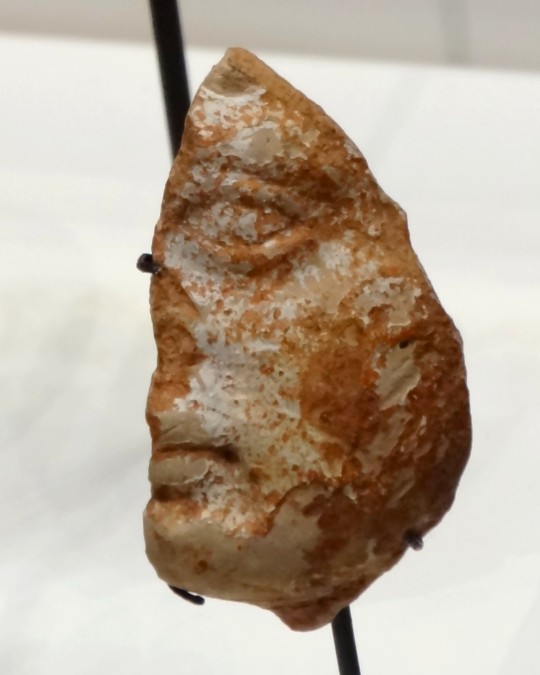

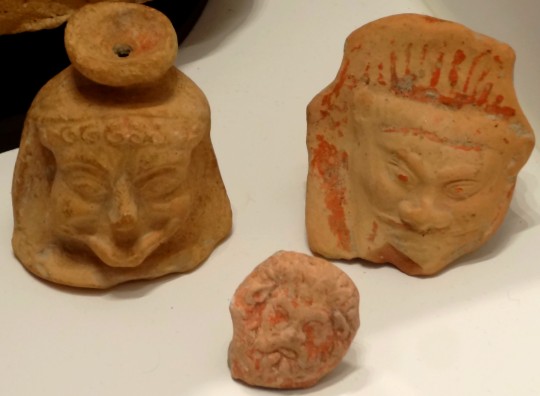

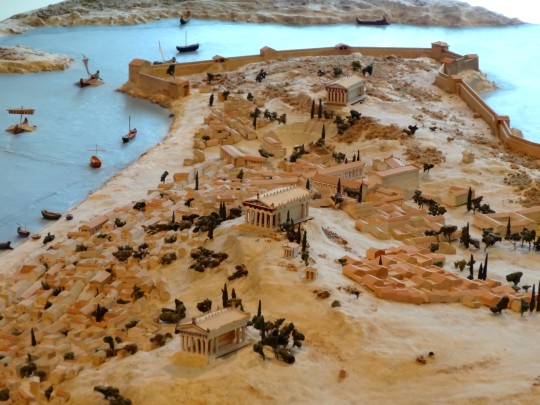
Nouveau retour à mon projet de présenter la plupart de mes 55500 photos (et des brouettes). Plus trop loin du présent....
Le Musée d’Histoire
- “Hermès" bicéphale celto-ligure - Roquepertuse
- coupe - Marseille, 540 av.J-C
- tête - grottes de Marseilleveyre - 400 av.J-C
- coupe avec amazonomachie - Marseille, 400 av.J-C
- Musée d'Histoire - vases - Marseille, 500 av.J-C
- amphores romaines, Les Pennes-Mirabeau 100avJC
- maquette de Massalia grecque.
#souvenirs#marseille#musée d'histoire#massalia#massilia#grèce antique#hermès de roquepertuse#hermès bicéphale#roquepertuse#ligure#marseilleveyre#amazonomachie#amazone#amphore#les pennes-mirabeau#maquette
4 notes
·
View notes
Text
*NPC vagueing about my daughter of Nike PC, Nina*
Chuck, my husband's son of Dionysus PC, who is one of Nina's exactly two friends: oh, are you referring to Larry? short, violent, Larry?
NPC: yes, i think so. what can you tell me about . . . Larry?
Chuck: hmm, well, she does have a temper. she also has a brain problem . . . not like medical—like, social skills. she basically killed a chimera. she did kill Nemesis, or however it works with gods. . . . oh! and she made cement! impossible cement!
NPC, trying to decide whether she should be impressed or concerned: okay then
#ttrpg stories#nina grayson#the amazonomachy#confusion crew#pjo oc#percy jackson oc#shit my players say#i promise the cement thing was actually very impressive i'm so proud of her for it
1 note
·
View note
Photo


“How about a play,” you asked.
“A play?” the Doctor said.
“Yeah, like theatre. I like theatre!”
“Sure, but theatre’s history is long. Shakespeare, Tennessee Williams, Lin-Manuel Miranda, Plautus, Albert Camus… when do you want to go?”
“Surprise me!”
“Surprise you,” the Doctor said, suddenly standing still, like he was in disbelief, “Well, hang on to something.”
You barely had time to get ahold of the railing before the TARDIS launched you forward.
You had been travelling with the Doctor for a few days now, and you already felt at home. Yes, this had been the most dangerous thing you had ever done, but it was also the most thrilling thing.
Soon enough, the Tardis landed and you regained your footing.
“So, where are we?” you asked.
“Go ahead and find out.”
You opened the TARDIS’ door to one of the most unique views you ever witnessed. The TARDIS had landed right by what seemed to be a fortress wall. You were so high in the sky that it felt like being at the very top of the world. The city below your feet didn’t give much information about where or when you were. You turned around trying to find some clue when you saw it. The Parthenon. Your heart skipped a beat. This was what you had been studying for the past year at university. And it was there, complete, in all its glory. The outside columns were all standing tall and followed the Doric canon in their number. And the metopes, oh the metopes they were all there, completely intact. From where you were standing, you could make out the scenes from the fight between the Centaurs and the Lapiths. You had to see the other sides, the ones that were destroyed. How did they represent the Trojan war on there? Or even the Amazonomachy?
“Care to take a guess,” the Doctor said, bending over your shoulder and cutting short your daydreaming
“Ancient Greece? Maybe Athens?”
“Precisely!”
He seemed so excited. You knew he was probably dying to show off what he knew and explain it in details to you. That’s what he always did, and you loved it. Seeing someone be so passionate about something they seemingly care about always brought a smile to your face. That’s why you loved school. And learning, learning is just so fun when it comes from the right person. Looking at him now, you knew it would break his heart a little if you told him you already knew a lot about this place. Still, there was one thing you couldn’t really guess.
“And when exactly?” you finally asked.
“Well… you know the Ancient times of Greece…”
“But like, month, year?”
The Doctor put on his sunglasses and turned three times on himself. He then suddenly dropped to his knees. You were sure he was about to lick the ground, as he had done already twice since you met him, but he looked like he was only listening very carefully.
“What are you…” you started.
“Shhhh! You’ll mess it up!”
He got back up and picked a fruit from the basket of an Athenian who was walking by.
“I’d say end of march, maybe begin of April, 405 before,” he said, throwing the fruit your way, “Well, that is based on our Gregorian calendar.”
“How did you know?” you said, barely catching the fruit.
He had a really shitty aim.
“Educated guess,” he said, “Oh and everyone is excited to see Euripides last tragedy. Should we get going?”
“We’re going to see The Bacchae?”
“Oh yes, he’s amazing, you’ll see.”
Together, you walked down to the Theatre of Dionysus. You couldn’t believe it. You were here, walking in Athens in Ancient Greece. A place you studied and loved for so long. You dreamt of going to Athens, the modern one that is, this couldn’t possibly be real.
You finally sat down, almost centred with the orchestra.
“How did you know it was The Bacchae?” the Doctor asked.
“Educated guess?”
“Right! So you see this place in the middle, it’s called the orchestra. This is where the chorus is going to stay for the entirety of the play. You see, once they’re on stage they never leave. They’ll get here by walking through the eisodos, well eisodoi, it’s plural, it’s those little passageways on each side.
You nodded and smiled as he said all that. Of course you already knew it, but he looked so happy.
“And right at the back, that building with the doors, is the skené, where the actors basically go and change costumes.”
“Well, it’s a bit more than that, but go on.
“And so you see tragedies are always presented in groups of three… wait, what did you just say?”
“No-nothing, go on. I’m listening,” you said.
You didn’t even notice that you had cut him off. You saw his smile fade away as you looked down embarrassed.
“Do you know about this?” he asked.
“You can keep explaining, I won’t cut you off again.”
“That’s not my question Y/N, if you already knew everything I explained, why didn’t you just tell me?”
“Because you’re always excited to talk about stuff you know and to explain it to me. I didn’t want to… to take that away from you,” you said, looking back at him, “And you seem happy when that happens… you rarely seem happy…”
“Oh… Y/N… I’m… you’re right, I love explaining things to you because I see how much YOU love it. You can explain it, it will make me just as happy.”
You looked at him, smiling softly. You knew this wasn’t true. You knew you could never make him truly happy. Something or someone tore a hole in his heart a long time ago and there was nothing you could do to fix it. No way you could patch it up, but you could always try to ease the pain.
“Right,” you said, “I’m sorry.”
“Don’t be, please,” he said, putting a protective arm around you as more people were coming in, “I promise this trip will be just as fun if you do the explaining and I do the listening.”
You grabbed the front of his jacket. People around you were now pushing, trying to find a seat.
“You’re sure you’ll be fine, only listening?” you asked.
“Yeah, yeah don’t even worry a little bit.” he said, smiling at you, “And Y/N don’t ever compromise who you are for me. You’re one of the most amazing people I’ve ever met. You don’t have to change who you are for anyone else.”
“I’ll try…”
“Thank you. Now, where did I go wrong?”
“Okay, so you see the skené is actually part of the play, it’s basically the backdrop. It tells us where we are and most importantly when the actors enter the skené, where they go. Because, yes they change costumes, but sometimes they leave because their character is doing something inside the palace for example. Most of the time, it’s dying because no deaths are represented on stage. Also, tragedies actually come in a group of four because the author also writes a satyr play. And we are so lucky to see The Bacchae! We rarely have a god as the protagonist, so this is exceptional but also you could say that at the end of the play when…”
“Maybe don’t spoil it for the people around,” the Doctor whispered, as the first tragedy was about to start, “we can talk plenty after.”
#mindful-of-ideas#doctor who imagine#twelfth doctor imagine#12th doctor imagine#doctor who#twelfth doctor#12th doctor#classics#classical studies#ancient greece
56 notes
·
View notes